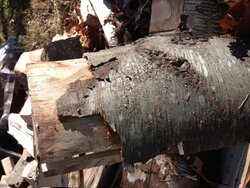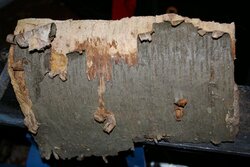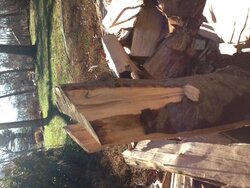Wood ID please- need to know this wood that is kicking my back !
- Thread starter metrowlogger
- Start date
-
Active since 1995, Hearth.com is THE place on the internet for free information and advice about wood stoves, pellet stoves and other energy saving equipment.
We strive to provide opinions, articles, discussions and history related to Hearth Products and in a more general sense, energy issues.
We promote the EFFICIENT, RESPONSIBLE, CLEAN and SAFE use of all fuels, whether renewable or fossil.
You are using an out of date browser. It may not display this or other websites correctly.
You should upgrade or use an alternative browser.
You should upgrade or use an alternative browser.
- Status
- Not open for further replies.
paul bunion
Minister of Fire
Black cherry or Black birch. Does it smell like root beer once split?
Black birch. Very high in Btu content. Keep it dry, it has a tendency to rot out fast.
No rootbeer smell but i wish it did!!
UncleJoe
Burning Hunk
firefighterjake
Minister of Fire
Backwoods Savage
Minister of Fire
red oak
Minister of Fire
Black cherry. After splitting mostly red oak, cherry can be a real pain. Had one last year that was 36" diameter and it just laughed at the maul. A couple of pieces still laughed at the wedge and sledge hammer. None laughed at the chainsaw though.
Lakeside
Minister of Fire
Looks like old ( not freshly cut green) black birch to me, usually the root beer smell is not as prevalent if it has been sitting for a while.
Last edited:
Paulywalnut
Minister of Fire
Hogwildz
Minister of Fire
TreePointer
Minister of Fire
Black cherry? No. (Prunus serotina)
Bird/sweet cherry? Likely. (Prunus avium)
If Prunus avium, the end grain of a round will look like black cherry. Black cherry won't have the smooth bark with prominent horizontal lenticels when it gets that big; black cherry's smooth bark will separate into scaly plates well before it gets that big.
Here's part of an ancient one on our farm:

Some smaller firewood:



Bird/sweet cherry? Likely. (Prunus avium)
If Prunus avium, the end grain of a round will look like black cherry. Black cherry won't have the smooth bark with prominent horizontal lenticels when it gets that big; black cherry's smooth bark will separate into scaly plates well before it gets that big.
Here's part of an ancient one on our farm:

Some smaller firewood:



Last edited:
paul bunion
Minister of Fire
TreePointer
Minister of Fire
Pictures can be deceiving, so I'm open to black birch.
OP, how about a shot of end grain of a freshly bucked log? Or any end grain?
OP, how about a shot of end grain of a freshly bucked log? Or any end grain?
Applesister
Minister of Fire
I've never split Black birch thats been sitting. But last spring my cousin cut one down for me in April. Never again. The stump ran like a geyser.
With a tree that has BTUs rated as high as hickory and a drying season of 1 year, I've never let the wood sit and get punky.
In my little operation this species becomes part of my private stash. Along with Shagbark hickory.
In fact I just loaded the stove with it. Supposed to get in the teens tonight. And its snowing.
With a tree that has BTUs rated as high as hickory and a drying season of 1 year, I've never let the wood sit and get punky.
In my little operation this species becomes part of my private stash. Along with Shagbark hickory.
In fact I just loaded the stove with it. Supposed to get in the teens tonight. And its snowing.
TreePointer
Minister of Fire
I've never split black birch, but I do know that I'll never again try splitting yellow birch without powerful hydraulics.
iserabl
Yes I think you have it
Yes i would agree...
Attachments
Yes I think you have it
Yes i would agree...
I got about 4 cords of this delivered in log length from construction buddy and bucked it into 24" rounds then had to cut them in half just to be able to hand split it with my fiskars axe.
PA. Woodsman
Minister of Fire
Black cherry? No. (Prunus serotina)
Bird/sweet cherry? Likely. (Prunus avium)
If Prunus avium, the end grain of a round will look like black cherry. Black cherry won't have the smooth bark with prominent horizontal lenticels when it gets that big; black cherry's smooth bark will separate into scaly plates well before it gets that big.
Here's part of an ancient one on our farm:

Some smaller firewood:



My "National Audobon Society Field Guide to North American Trees" shows this what you have here called "Pin" Cherry; I see it on a rather consistent basis here in Eastern PA. Has a different, unique odor to it than Black Cherry, and definitely not the Wintergreen odor that Black Birch has. But it is still in the Cherry family!
Bigg_Redd
Minister of Fire
CenterTree
Minister of Fire
LOL, I was really waiting for someone to say that.It's definitely firewood. Hope this helps.

-----------------
I think it is Blk Birch. Even if it has no root beer smell in the cut log,,,usually the stronger odor is found in the smaller branches/twigs.
Disclaimer: I have been known to be wrong.
(once)
Side note: It's interesting the difference of opinions on splitting different types of wood... I find Red Oak to be very hard and don't want to split by hand unless I am just re-splitting for kindling etc, whereas the cherry I've been working on splits like butter with my cheap harbor freight ax. I bet a lot varies from tree to tree and knots as well as how long it's sat.
TreePointer
Minister of Fire
My "National Audobon Society Field Guide to North American Trees" shows this what you have here called "Pin" Cherry; I see it on a rather consistent basis here in Eastern PA. Has a different, unique odor to it than Black Cherry, and definitely not the Wintergreen odor that Black Birch has. But it is still in the Cherry family!
This has been discussed in more than one forum. If you use ONLY the NAS Field Guide, it's reasonable to conclude that it's Prunus pennsylvanica (pin cherry or fire cherry). Other guides and references have this tree as Prunus avium (bird cherry or sweet cherry). In this case, the NAS Field Guide goofed.
For example, Dendrology at VA Tech essentially contradicts the NAS Field Guide, by having pictures and descriptions of these two reversed from the NAS Field Guide.
http://dendro.cnre.vt.edu/dendrology/syllabus/factsheet.cfm?ID=154
http://dendro.cnre.vt.edu/dendrology/syllabus/factsheet.cfm?ID=63
If you go in the field to ID this tree with the NAS Field Guide by twigs, leaf scars, buds, fruit, and especially the leaves, the difference is clear. The distinctive glands on the leaf petiole are a good tell.

One of the problems is common names. P. pennsylvanica and P. avium are both referred to as "bird cherry." Both of those and also P. serotina (black cherry) are all referred to as wild cherry.
Even though P. avium is not native here, it's been around a long time and has become well established in North America
Last edited:
- Status
- Not open for further replies.
Similar threads
- Replies
- 24
- Views
- 3K
- Replies
- 28
- Views
- 2K




